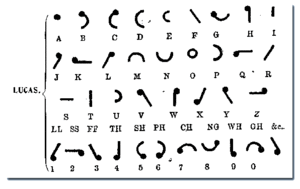Thomas Lucas (educator) facts for kids
Quick facts for kids
Thomas Lucas
|
|
|---|---|
| Born |
Thomas Mark Lucas
c. 1764 Bristol, England
|
| Died | (aged 73) London, England
|
| Nationality | English |
| Occupation | merchant, shorthand teacher, and educator of the blind |
| Known for | Lucas system of tactile alphabet for the blind |
Thomas Mark Lucas (born around 1764 – died May 18, 1838) was an important British teacher who helped blind people. He started the Royal London Society for Blind People. He also created his own special way for blind people to read, called the Lucas system. This system was another option besides Braille.
Thomas Lucas: Early Life
Thomas Mark Lucas was born in Bristol, England, around 1764. We don't know much about his early family life. However, he received a small Bible from his father when he was young. He remained a very religious person throughout his life.
By the early 1800s, Lucas lived in Bristol. He worked as a merchant and taught shorthand. Shorthand is a quick way of writing using special symbols. Around this time, Lucas became interested in helping blind people learn to read. He thought of using simple shorthand symbols that could be felt with fingers.
The Lucas System for Reading
Around 1830 to 1832, Thomas Lucas created his reading system. It was called the Lucas system, or Lucas type. This system used raised (embossed) text, which means the letters stuck out from the page. It was a type of "shorthand" alphabet for blind people. The symbols were chosen by Lucas and included strokes, some with a dot at the end.
The symbols in the Lucas system looked simple. But in practice, they could be confusing because similar symbols were used in many places. Because of this, the system was not used by everyone. However, the Lucas system was one of the first shorthand systems made for blind people. It was used in the UK before the Braille system became popular there.
Between 1830 and 1832, Lucas opened a small, free school in Bristol. He taught blind children shorthand and English grammar there. In 1836, Lucas and 15 other important people in Bristol formed a group. This group was called The Bristol Society for Embossing and Circulating the Authorised Version of the Bible for the use of the Blind. Their goal was to raise money to print parts of the Bible using the Lucas system.
In 1837, Lucas published a book. It was called Instructions for Teaching the Blind to Read with the Britannic or Universal Alphabet, and Embossing their Lessons &c. He wrote this book to help promote his system. He also called his system the Britannic or Universal Alphabet. Lucas gave public talks to show how his system worked. His blind students would even show how well they could read.
Lucas hoped his system would become the only way for blind people to read "by feel." But in the 1830s and 1840s, many different systems were being used. To make his system more known, Lucas traveled to London in 1838. He showed how his system worked and how successful his students were. This led to the start of the London Society for Teaching the Blind to Read. This group later became the Royal London Society for Blind People (RLSB). In London, 31 students learned to read and write using the Lucas system. Thomas Lucas died on May 18, 1838, soon after arriving in London.
The Lucas System's Legacy
The Lucas system continued to be used even after Thomas Lucas died. There are two books written in the Lucas system that still exist today. They are kept in the Royal National Institute of Blind People collections. One is The Gospel According to Saint John (from 1837). The other is Mother's Last Words (from 1868), which was published after Lucas's death.
From 1838 to the 1860s, the Lucas system was changed to work for other languages and for music. Books in the Lucas system were sent all over Britain and its empire. They also went to places like India and China. Almost all the Lucas system books that still exist in major UK libraries are religious texts. Some are also instructions on how to teach and use the system. One of the last books published in the Lucas system was Fifty Anecdotes on Various Subjects. It was published in 1867. A rare machine used to create the raised letters for the Lucas system is kept at the Science Museum, London.
In 1871, the Lucas system was still used in seven schools for the blind. At that time, Braille was only used in four schools. It wasn't until 1891 that the Royal London Society for Blind People stopped making materials using the Lucas system. They had stopped teaching the system earlier, in 1861. By the 1890s, the Braille system had become the main way for blind people to read "by feel."


